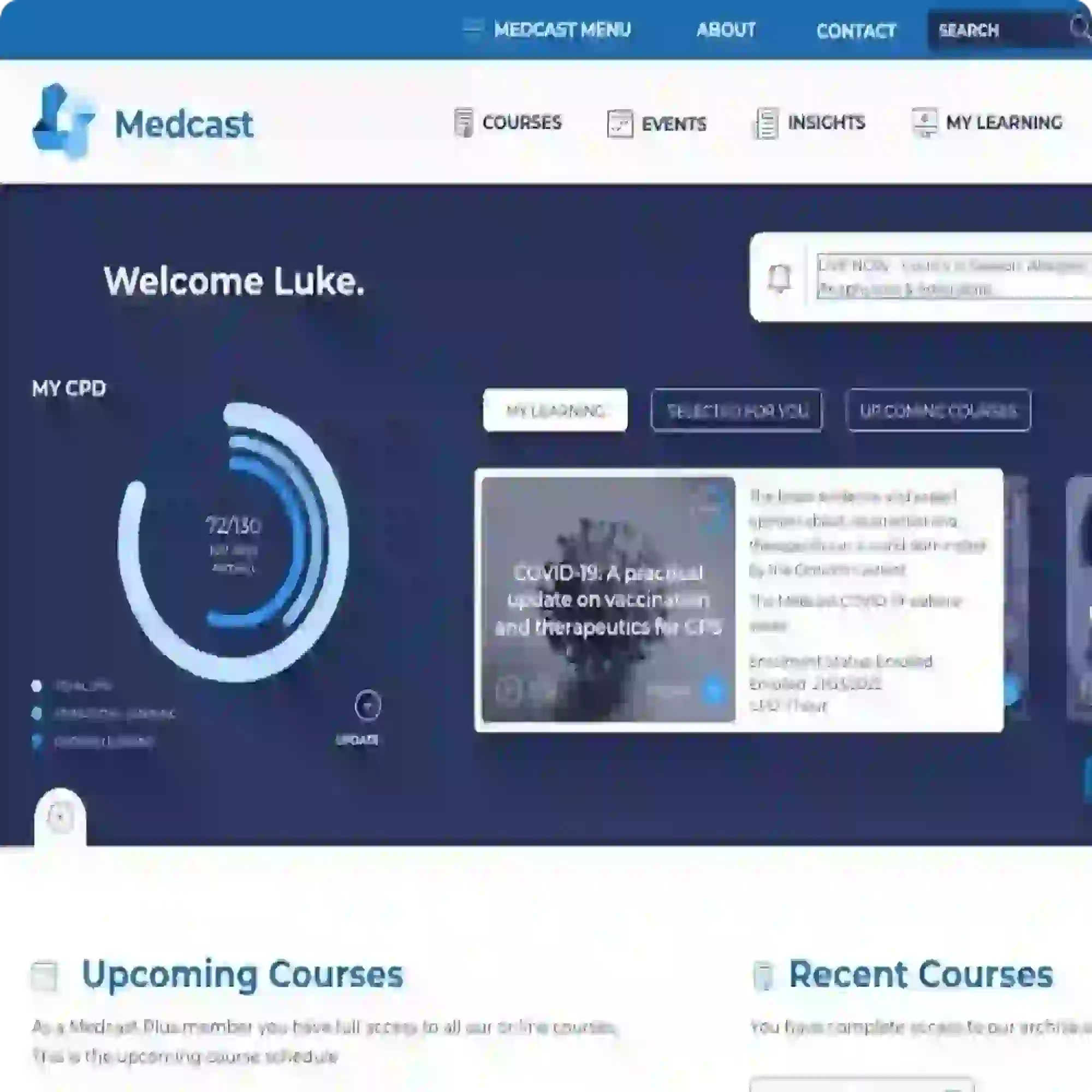Atrial fibrillation stroke prevention - clinical fact sheet and MCQ
![]()
This is the second FastTrack on atrial fibrillation (AF). Part 1 describes the diagnosis, initial assessment of AF, and indications for urgent review. This FastTrack describes the approach to setting a management strategy using risk calculators, how to assess and reduce risk factors, and long term monitoring of patients with AF.
Overview of atrial fibrillation
AF affects one in 20 individuals over 65 years and carries a fivefold increased risk of ischaemic stroke.1
Stroke related to AF is typically more severe and disabling compared with ischaemic strokes from other causes.2 Effective stroke prevention strategies, including anticoagulation and risk factor modification, significantly reduce morbidity and mortality.
AF diagnosis
Many patients with AF can be safely managed by the GP (eg those with a controlled ventricular rate and no other significant heart disease), with cardiologist consultation only if required.3
Most patients diagnosed with AF will require further investigations, including a transthoracic echocardiogram. While these tests are important for ongoing management, they can often involve long wait times. Stroke risk assessment and, where indicated, initiation of anticoagulation should not be delayed while awaiting investigation results.
For a detailed clinical summary on diagnosis, please review our Atrial fibrillation diagnosis and assessment - clinical fact sheet and MCQs.
Referral criteria
Refer to cardiologist if:
- unsure about diagnosis, eg paroxysmal AF
- persistent heart rate >110 bpm despite maximal therapy
- considering cardioversion
- contraindication to anticoagulation
Management: stroke prevention in AF
Following a diagnosis of AF all patients should have their stroke risk assessed with a validated scoring tool.
1. Stroke risk assessment
Stroke risk varies, and the CHA2DS2–VA calculator4 is the most widely used in clinical practice to estimate the risk of stroke in AF.5 Points are assigned based on the following parameters:
C – Chronic heart failure (1 point)
H – Hypertension (current or previous history) (1 point)
A – Aged ≥75 years (2 points)
D – Diabetes mellitus (1 point)
S – Stroke history, transient ischaemic attack, or thromboembolism (2 points)
V – Vascular disease (peripheral artery disease, complex aortic plaque or prior myocardial infarction) (1 point)
A – Aged ≥65 to <75 years (1 point).
There are other tools available, such as the GARFIELD-AF calculator, which offer more precise risk prediction including bleeding and mortality but require more detailed data.3,6
Note: Consider other factors associated with elevated thromboembolic risk including cancer, chronic kidney disease, ethnicity (eg First Nations people, Asian), biomarkers (troponin and B-type natriuretic peptide), and in specific groups, atrial enlargement, hyperlipidaemia, smoking and obesity.7,8
2. Anticoagulation for stroke prevention
The cornerstone of stroke prevention in AF is the use of oral anticoagulants, which can reduce stroke risk by up to 70%.3 Anticoagulation is usually needed long term whether a rate control strategy or a long-term rhythm control strategy is adopted. Timely initiation of anticoagulants should occur as indicated and this does not routinely require specialist management.3
For details regarding dose and additional clinical considerations see - Anticoagulant management for atrial fibrillation
Direct-acting oral anticoagulants (DOACs)
- DOACs are suitable for most patients, including those with bioprosthetic valves and/or mitral regurgitation.
-
Which DOAC to choose? Apixaban, dabigatran and rivaroxaban are considered equal first line as there is no head to head data available.
-
Compared with warfarin, DOACs have a lower risk of intracranial haemorrhage, and a fixed dosing schedule so there is no need for therapeutic drug monitoring.
Warfarin
-
Indicated for some patients, including those with rheumatic mitral stenosis, mechanical heart valves and/or antiphospholipid syndrome
Bleeding risk and contraindications to anticoagulation
Bleeding risk scores should almost never preclude the use of anticoagulants as the benefits of stroke prevention almost always outweigh the risk of major bleeding. They can be used to help determine the risk–benefit balance of anticoagulation and in identifying potentially correctable bleeding risk factors. The most common scoring tool is the HAS-BLED score, which includes risk factors for bleeding such as hypertension, abnormal kidney or liver function, prior stroke, history of bleeding, labile INR, age, and other drug or alcohol use. Pregnant women should be urgently referred for specialist advice and consideration of alternative anticoagulants eg, enoxaparin.
Absolute contraindications to anticoagulation include:
-
severe renal impairment (DOACs)
-
severe hepatic disease (DOACs)
-
active serious bleeding
-
severe thrombocytopaenia
Urgently refer patients with contraindications to oral anticoagulants to a cardiologist for consideration of alternative stroke prevention strategies, eg left atrial appendage occlusion.
Identify and correct bleeding risk factors
-
Alcohol: advise patient to limit alcohol intake to <3 standard drinks per week
-
Antiplatelets: assess indication for ongoing use and deprescribe if appropriate
-
High gastrointestinal bleeding risk: offer proton pump inhibitor
-
Hypertension: optimise BP-lowering treatment
-
NSAIDs: use alternative where appropriate
Other bleeding risk mitigation strategies
-
Reduce corticosteroid use if possible
-
Restrict hazardous activity
-
Assess falls risk and reduce where possible
-
Optimise comorbidity management
3. Patient education and ongoing review
-
Educate patients on signs of bleeding and stroke, and the importance of ongoing adherence to anticoagulant therapy
-
Regular CHA₂DS₂-VA reassessment, at least annually for patients with an initial calculated risk of ≤1
-
Regular monitoring of:
-
AF symptoms and burden of disease
-
medication management including tolerance and adherence
-
comorbidity management and cardiovascular health
-
renal function
-
lifestyle factors (smoking, alcohol, obesity)
Download a personalised anticoagulant plan to use with your patients here.
References
3. Topic | Therapeutic Guidelines | Atrial fibrillation and atrial flutter [Internet]. (last accessed Nov 2024).
4. CHA₂DS₂-VA Score for Atrial Fibrillation Stroke Risk [Internet]. MDCalc. (last accessed Feb 2025).
7. Van Gelder IC, Rienstra M, Bunting KV, Casado-Arroyo R, Caso V, Crijns HJGM, et al. 2024 ESC Guidelines for the management of atrial fibrillation developed in collaboration with the European Association for Cardio-Thoracic Surgery (EACTS): Developed by the task force for the management of atrial fibrillation of the European Society of Cardiology (ESC), with the special contribution of the European Heart Rhythm Association (EHRA) of the ESC. Endorsed by the European Stroke Organisation (ESO). Eur Heart J [Internet]. 2024;45(36):3314–414. Available from: https://doi.org/10.1093/eurheartj/ehae176. (last accessed Oct 2024).
8. Balabanski AH, Nedkoff L, Brown A, Thrift AG, Pearson O, Guthridge S, et al. Incidence of Stroke in the Aboriginal and Non-Aboriginal Populations of Australia: A Data Linkage Study. Stroke [Internet]. 2023;;54(8):2050–8. (last accessed Jan 2025).
Claim your CPD
After reading the clinical summary above and reviewing the references, complete the quiz to gain 30 minutes of EA CPD and 30 minutes of RP CPD.
You can either self-report CPD to your CPD home, or Medcast will track your learning via your personal CPD Tracker and you can download and report these points once a year. See our CPD Tracker FAQ.
Quiz
Please log in or sign up for a free Medcast account to access the case study questions and achieve the CPD credits.

The Quality Use of Medicines Alliance is a unique consortium of health sector organisations representing quality use of medicines expertise, education providers, researchers, colleges, peak bodies, member-based organisations, and consumer groups. Funded by the Australian Government under the Quality Use of Diagnostics, Therapeutics and Pathology (QUDTP) Program.
Over 3% of GP consultations in Australia involve skin lesions, yet many practices are billing these procedures incorrectly, putting themselves at risk of noncompliance or missing out on legitimate remuneration. This Business skills FastTrack explains the MBS item numbers pertaining to skin lesions for GPs, including eligibility criteria and practical tips.
With one in three young Australians experiencing a mental health condition each year, and suicide remaining the leading cause of death for 16 to 24-year-olds, the way clinicians approach antidepressant use in teens and young adults has never been more important.
Sarcoidosis is a chronic non-caseating granulomatous condition affecting multiple organ systems. This fact sheet contains what GPs need to know about risk factors, investigations, pharmacological and non-pharmacological management in primary practice, and when to refer. 30mins each of RP and EA CPD available with the quiz.

